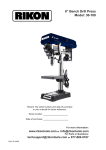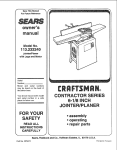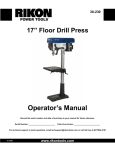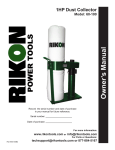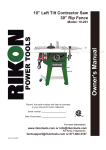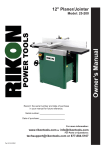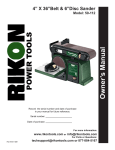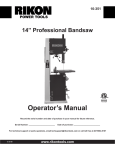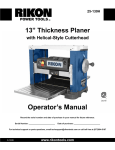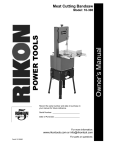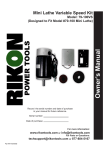Download Rikon Power Tools 50-151 Operator`s manual
Transcript
50-151 1” X 30” Belt / 5” Disc Sander Operator’s Manual Record the serial number and date of purchase in your manual for future reference. Serial Number: _________________________ Date of purchase: _________________________ For technical support or parts questions, email [email protected] or call toll free at (877)884-5167 50-151M2 www.rikontools.com TABLE OF CONTENTS Specifications ........................................................................................................................................2 Safety Instructions..............................................................................................................................3 - 6 Electrical Requirements ..............................................................................................................5, 6, 16 Sander Safety Rules .......................................................................................................................7 Contents of Package ............................................................................................................................................8 Getting to Know Your Sander .................................................................................................................................9 Assembly ...........................................................................................................................9 - 11 General Use............................................................................................................11 - 14 Maintenance ...................................................................................................................................14 Trouble Shooting........................................................................................................................................15 - 16 Wiring Diagram.................................................................................................................................16 Parts Explosion................................................................................................................................17 Parts List .....................................................................................................................................18 Warranty .............................................................................................................................................19 SPECIFICATIONS Model No. Motor Horsepower Amps Volts Belt Size Speed Tilt Disc Diameter Speed Table Size Tilt Miter Gauge Miter Gauge Slot Overall Height Width Depth Base Size Net Weight Shipping Weight Shipping Carton Warranty 50-151 1/3 HP 2.3 120V, 60 Hz 1" x 30" 3,340 SFPM 0° - 45° 5" PSA 3,340 RPM 7-1/4" x 3-3/4" 0° - 45° Included 1/4" x 7/16" 14-5/8" 15" 12-5/8" 8-1/4" x 6" 15.5 lbs 19.5 lbs. 17-1/2" x 12-1/4" x 11-1/2" 5 Years This owner’s manual is not a teaching aid and is intended to show assembly, adjustments, and general use. NOTE: The specifications, photographs, drawings and information in this manual represent the current model when the manual was prepared. Changes and improvements may be made at any time, with no obligation on the part of Rikon Power Tools, Inc. to modify previously delivered units. Reasonable care has been taken to ensure that the information in this manual is correct, to provide you with the guidelines for the proper safety, assembly and operation of this machine. 2 SAFETY SYMBOLS The purpose of safety symbols is to attract your attention to possible dangers. The safety symbols and the explanations with them deserve your careful attention and understanding. The symbol warnings do not, by themselves, eliminate the danger. The instructions and warnings they give are no substitutes for proper accident prevention measures. THIS SYMBOL DESIGNATES THAT THIS TOOL IS LISTED BY THE INTERTEK TESTING SERVICES, TO UNITED STATES AND CANADIAN STANDARDS 3 SAFETY INSTRUCTIONS IMPORTANT! Safety is the single most important consideration in the operation of this equipment. The following instructions must be followed at all times. There are certain applications for which this tool was designed. We strongly recommend that this tool not be modified and/ or used for any other application other than that for which it was designed. If you have any questions about its application, do not use the tool until you have contacted us and we have advised you. GENERAL SAFETY KNOW YOUR POWER TOOL. Read the owner’s manual carefully. Learn the tool’s applications, work capabilities, and its specific potential hazards. BEFORE USING YOUR MACHINE To avoid serious injury and damage to the tool, read and follow all of the Safety and Operating Instructions before operating the machine. 1. CALIFORNIA PROPOSITION 65 Some dust created by power sanding, sawing, grinding, drilling and other construction activities contains chemicals known to the State of California to cause cancer, birth defects, or other reproductive harm. Some examples of these chemicals are: - Lead from lead-based paints. - Crystalline silica from bricks, cement, and other masonry products. - Arsenic and chromium from chemically treated lumber. Your risk from these exposures varies, depending on how often you do this type of work. To reduce your exposure to these chemicals: work in a well ventilated area and work with approved safety equipment, such as those dust masks that are specially designed to filter out microscopic particles. 2. READ the entire Owner’s Manual. LEARN how to use the tool for its intended applications. 6. ALWAYS keep the work area clean, well lit, and organized. DO NOT work in an environment with floor surfaces that are slippery from debris, grease, and wax. 7. KEEP VISITORS AND CHILDREN AWAY. DO NOT permit people to be in the immediate work area, especially when the electrical tool is operating. 8. DO NOT FORCE THE TOOL to perform an operation for which it was not designed. It will do a safer and higher quality job by only performing operations for which the tool was intended. 9. WEAR PROPER CLOTHING. DO NOT wear loose clothing, gloves, neckties, or jewelry. These items can get caught in the machine during operations and pull the operator into the moving parts. The user must wear a protective cover on their hair, if the hair is long, to prevent it from contacting any moving parts. 10. CHILDPROOF THE WORKSHOP AREA by removing switch keys, unplugging tools from the electrical receptacles, and using padlocks. 11. ALWAYS UNPLUG THE TOOL FROM THE ELECTRICAL RECEPTACLE when making adjustments, changing parts or performing any maintenance. 12. KEEP PROTECTIVE GUARDS IN PLACE AND IN WORKING ORDER. 13. AVOID ACCIDENTAL STARTING. Make sure that the power switch is in the “OFF” position before plugging in the power cord to the electrical receptacle. 3. GROUND ALL TOOLS. If the tool is supplied with a 3-prong plug, it must be plugged into a 3-contact electrical receptacle. The 3rd prong is used to ground the tool and 14. REMOVE ALL MAINTENANCE TOOLS from the provide protection against accidental electric shock. DO immediate area prior to turning “ON” the machine. NOT remove the 3rd prong. See Grounding Instructions on the following pages. 15. USE ONLY RECOMMENDED ACCESSORIES. Use of incorrect or improper accessories could cause serious 4. AVOID A DANGEROUS WORKING ENVIRONMENT. injury to the operator and cause damage to the tool. If in DO NOT use electrical tools in a damp environment or doubt, check the instruction manual that comes with that expose them to rain. particular accessory. 5. DO NOT use electrical tools in the presence of flammable liquids or gasses. 4 SAFETY INSTRUCTIONS 16. NEVER LEAVE A RUNNING TOOL UNATTENDED. Turn the power switch to the “OFF” position. DO NOT leave the tool until it has come to a complete stop. 26. USE A PROPER EXTENSION CORD IN GOOD CONDITION. When using an extension cord, be sure to use one heavy enough to carry the current your product will draw. The table on the following page shows the cor17. DO NOT STAND ON A TOOL. Serious injury could rect size to use depending on cord length and nameplate result if the tool tips over, or you accidentally contact the amperage rating. If in doubt, use the next heavier gauge. tool. The smaller the gauge number, the larger diameter of the extension cord. If in doubt of the proper size of an exten18. DO NOT store anything above or near the tool where sion cord, use a shorter and thicker cord. An undersized anyone might try to stand on the tool to reach it. cord will cause a drop in line voltage resulting in a loss of power and overheating. 19. MAINTAIN YOUR BALANCE. DO NOT extend USE ONLY A 3-WIRE EXTENSION CORD THAT HAS yourself over the tool. Wear oil resistant rubber soled A 3-PRONG GROUNDING PLUG AND A 3-POLE shoes. Keep floor clear of debris, grease, and wax. RECEPTACLE THAT ACCEPTS THE TOOL’S PLUG. 20. MAINTAIN TOOLS WITH CARE. Always keep tools 27. ADDITIONAL INFORMATION regarding the safe and clean and in good working order. Keep all blades and tool proper operation of this product is available from: bits sharp, dress grinding wheels and change other abrasive accessories when worn. • Power Tool Institute 1300 Summer Avenue 21. EACH AND EVERY TIME, CHECK FOR DAMAGED Cleveland, OH 44115-2851 PARTS PRIOR TO USING THE TOOL. Carefully check all www.powertoolinstitute.org guards to see that they operate properly, are not damaged, and perform their intended functions. Check for alignment, • National Safety Council binding or breaking of moving parts. A guard or other part 1121 Spring Lake Drive that is damaged should be immediately repaired or Itasca, IL 60143-3201 replaced. www.nsc.org 22. DO NOT OPERATE TOOL WHILE TIRED, OR UNDER THE INFLUENCE OF DRUGS, MEDICATION OR ALCOHOL. 23. SECURE ALL WORK. Use clamps or jigs to secure the workpiece. This is safer than attempting to hold the workpiece with your hands. 24. STAY ALERT, WATCH WHAT YOU ARE DOING, AND USE COMMON SENSE WHEN OPERATING A POWER TOOL. A moment of inattention while operating power tools may result in serious personal injury. 25. ALWAYS WEAR A DUST MASK TO PREVENT INHALING DANGEROUS DUST OR AIRBORNE PARTICLES, including wood dust, crystalline silica dust and asbestos dust. Direct particles away from face and body. Always operate tool in well ventilated area and provide for proper dust removal. Use dust collection system wherever possible. Exposure to the dust may cause serious and permanent respiratory or other injury, including silicosis (a serious lung disease), cancer, and death. Avoid breathing the dust, and avoid prolonged contact with dust. Allowing dust to get into your mouth or eyes, or lay on your skin may promote absorption of harmful material. Always use properly fitting NIOSH/OSHA approved respiratory protection appropriate for the dust exposure, and wash exposed areas with soap and water. • American National Standards Institute 25 West 43rd Street, 4th Floor New York, NY 10036 www.ansi.org • ANSI 01.1 Safety Requirements for Woodworking Machines and the U.S. Department of Labor regulations www.osha.gov 28. SAVE THESE INSTRUCTIONS. Refer to them frequently and use them to instruct others. ELECTRICAL SAFETY THIS TOOL MUST BE GROUNDED WHILE IN USE TO PROTECT THE OPERATOR FROM ELECTRIC SHOCK. IN THE EVENT OF A MALFUNCTION OR BREAKDOWN, grounding provides the path of least resistance for electric current and reduces the risk of electric shock. This tool is equipped with an electric cord that has an equipment grounding conductor and a grounding plug. The plug MUST be plugged into a matching electrical receptacle that is properly installed and grounded in accordance with ALL local codes and ordinances. 5 SAFETY INSTRUCTIONS EXTENSION CORDS ELECTRICAL SAFETY (Continued) DO NOT MODIFY THE PLUG PROVIDED. If it will not fit the electrical receptacle, have the proper electrical receptacle installed by a qualified electrician. Keep the extension cord clear of the working area. Position the cord so that it will not get caught on lumber, tools or other obstructions while you are working with a power tool. IMPROPER ELECTRICAL CONNECTION of the equipment grounding conductor can result in risk of electric shock. The conductor with the green insulation (with or without yellow stripes) is the equipment grounding conductor. DO NOT connect the equipment grounding conductor to a live terminal if repair or replacement of the electric cord or plug is necessary. Check extension cords before each use. If damaged replace immediately. Never use a tool with a damaged cord, since touching the damaged area could cause electrical shock, resulting in serious injury. CHECK with a qualified electrician or service personnel if you do not completely understand the grounding instructions, or if you are not sure the tool is properly grounded. Use a proper extension cord. Only use cords listed by Underwriters Laboratories (UL). Other extension cords can cause a drop in line voltage, resulting in a loss of power and overheating of tool. When operating a power tool outdoors, use an outdoor extension cord marked “W-A” or “W”. These cords are rated for outdoor use and reduce the risk of electric shock. USE ONLY A 3-WIRE EXTENSION CORD THAT HAS A 3-PRONG GROUNDING PLUG AND A 3-POLE RECEPTACLE THAT ACCEPTS THE TOOL’S PLUG. REPLACE A DAMAGED OR WORN CORD IMMEDIATELY. This tool is intended for use on a circuit that has an electrical receptacle as shown in FIGURE 1. FIGURE 1 shows a 3-wire electrical plug and electrical receptacle that has a grounding conductor. If a properly grounded electrcal receptacle is not available, an adapter as shown in FIGURE 2 can be used to temporarily connect this plug to a 2-contact ungrounded receptacle. The adapter has a rigid lug extending from it that MUST be connected to a permanent earth ground, such as a properly grounded receptacle box. THIS ADAPTER IS PROHIBITED IN CANADA. Figure 1 Figure 2 6 SAFETY INSTRUCTIONS SPECIFIC SAFETY INSTRUCTIONS FOR BELT & DISC SANDERS 1. Do not operate this machine until you have read all of the following instructions. 2. Do not attempt to operate this machine until it is completely assembled. 3. Do not turn ON this machine if any pieces are damaged or missing. 4. This machine must be properly grounded. 5. If you are not familiar with the operation of the machine, obtain assistance from a qualified person. 6. It is highly recommended that this machine be firmly mounted to a flat and secure work surface or stand. 7. Always wear protective eyewear prior to operating this machine. 8. Always wear a dust mask and use adequate dust collection and proper ventilation. Use of sanders can produce harmful particles while sanding certain types of woods. 9. Do not wear loose clothing or jewelry when operating this machine. Keep long hair tied back. 10. Always make sure the power switch is in the OFF position prior to plugging in the machine. 11. Always make sure the power switch is in the OFF position when doing any assembly or setup operation. 12. Make sure all safety guards and hardware are securely tightened before operating the machine. 13. The use of any accessories or attachments not recommended may cause injury to you and damage your machine. 14. Abrasive discs and belts should be the recommended width and length of the manufacturer. 15. Replace worn, frayed or torn abrasives, as injury to the user, or the machine, may result. 16. Always keep your face and hands clear of moving parts such as belts, discs and pulleys. 17. Keep power supply cords free of moving parts of the sander. Damaged cords can result in electric shock. 18. Maintain a minimal gap clearance (1/8” or less) between the sanding disc or the sanding belt and their tables. 19. Always support the workpiece with the table or backstop during sanding. 20. Carefully feed work into the rotating sanding belt, or disc, on the downward direction, so that the abrasive action pushes the work down onto the tables where it can be controlled. 21. Do not force the work into the abrasives, as burning of the wood or stalling of the machine may result. SAVE THESE INSTRUCTIONS. Refer to them often. 7 CONTENTS OF PACKAGE Carefully unpack your sander from its carton, and check to make sure the following parts are included. If any parts are missing or broken, please call RIKON Customer Service (877-884-5167) as soon as possible for replacements. DO NOT turn your machine ON if any of these items are missing. You may cause injury to yourself or damage to the machine. Carton Contents: Item DescriptionQty A Belt & Disc Sander Assembly B Miter Gauge C Sanding Disc Cover D Dust Nozzie Adapter (1-1/2” O.D., 1-1/4” I.D.) 1 1 1 1 E Sanding Disc Work Table 1 F Locking Knob for Disc Table 2 G Sanding Belt Work Table 1 H Locking Knob for Belt Table 1 I Owner’s Manual 1 List of loose parts in bag: Description Washer 6 mm Qty Phillips Screw M4x10 Washer 8 mm 2 Description Qty Washer 4mm 3 Hex “L” Wrench 3mm 1 3 1 8 GETTING TO KNOW YOUR SANDER M A M B C L K I D E Item A. B. C. D. E. F. G. H. J H F N G O P G Description Item I. J. K. L. M. N. O. P. Sanding Belt 1” x 30” Sanding Belt Tracking Knob Sanding Belt Table Sanding Belt Table Lock Handle Sanding Belt Safety Cover ON/OFF Switch Disc Table Lock Handle Disc Table Angle Scale Description Sanding Disc 5” (PSA) Disc Table Miter Gauge Motor Sanding Belt Safety Cover Sanding Belt Dust Port Sanding Disc Dust Port Rubber Machine Feet ASSEMBLY THE SANDER MUST NOT BE PLUGGED IN AND THE POWER SWITCH MUST BE IN THE OFF POSITION UNTIL ASSEMBLY IS COMPLETE. Tools Required for Assembly: #2 Phillips Screwdriver Unpacking and Clean-up 1. Carefully remove all contents from the shipping carton. Compare the contents with the list of contents on the previous page. Place parts on a protected surface for easy identification and assembly. 2. Report any shipping damage to your local distributor. 3. Clean all rust protected surfaces. Do not use; gasoline, paint thinner, mineral spirits, etc. These may damage painted surfaces. 4. Set packing material and shipping carton to the side. Do not discard until the machine has been set up and is running properly. 9 ASSEMBLY ASSEMBLY AND INSTALLATION Always ensure the sander is unplugged prior to attempting any assembly, installation or changing of parts and accessories. Machine Bolt Lag Bolt Washer MOUNTING THE SANDER TO A WORKBENCH Machine Base CAUTION: If during operation there is any tendency for the sander to tip over, slide or walk on the supporting surface, the sander should be properly mounted to a workbench or stand. Rubber Foot Workbench Washer 1. Rubber feet are fastened to this sander prior to shipping. They may, or may not, be used when attaching the sander to a bench or stand. 2. Position the sander on the workbench. 3. Mark the workbench through the two mounting holes located in the left and right sides of the sander base (between the holes for rubber feet). 4. Drill holes in the workbench at the 2 marks. 5. Using long bolts, washers, lock-washers and nuts; or lag bolts; (fasteners not supplied), secure the sander to the workbench. FIG. A. Lock Washer Pilot Hole for Lag Bolt Nut FIG. A DUST CHUTE INSTALLATION – DISC SANDER 1. Fasten the sanding disc dust-chute and cover (Part #56) to the machine using the three Phillips M4 screws and washers (#21, 23). FIG. B. Dust Chute ASSEMBLING THE BELT SANDER TABLE FIG. B When assembling the belt & disc sander, ensure the machine is disconnected from any power source. Table 1. Locate the round shaped belt-sanding table (#41). 2. Position the table by threading the belt and plate through the table’s slot and square opening. 3. Fasten the table to the frame by using the tableadjustment knob and 8mm washer (#43, 42). FIG. C. 4. Bring the adjustment knob’s screw through the slot in the bracket opening on the underside of the table, then into the threaded hole in the frame that houses the hex nut (#17). 5. Fasten the table in place by using the adjustment handle to turn its integral screw into the nut. Adjustment Knob FIG. C 10 ASSEMBLING THE SANDING DISC TABLE Always ensure the sander is disconnected from the power supply prior to commencing work. 1. Attach the disc-sanding table (#64) to the sanding disc guard (#71) by tipping the table up, and slide the two small nipples extending from the rectangular mouth of the table, onto the 2 ‘L’ mounting slots in the sides of the disc sander guide’s frame. FIG. D. 2. Align the two screw holes in the guard with the arched slots above the angle gauges, so that the knobs & 6mm washers (#66,65) will travel through the angle-gauge openings on either side of the disc into the mounting holes on the disc sander. 3. Using the disc-table adjustment handles, fasten the table to the sander. 4. When required for sanding small parts or for sanding to specific angles, use the miter gauge which slides in the slot on the disc-sanding table. FIG. D BELT TABLE ADJUSTMENTS Always ensure the sander is disconnected from the power supply prior to commencing work. For most sanding operations, the table will likely remain at a 90º angle to the belt. A positive stop is provided with your sander to ensure fast positioning of the table at 90 degrees to the belt. To ensure and check the positive-stop 90º angle, proceed as follows: 1. Loosen the table-locking lever / knob (#43). 2. Tilt the table back to the rear as far as possible. 3. Using a square, protractor or other 90º tool, measure the angle of the table against the platen (#22). FIG. E. To adjust the table angle to ensure a 90º angle, turn the table’s rear adjustment screw (#40) as needed, and once the 90º is setting is found, lock it in place with the hex nut (#18), that is under the table. 4. To set the table to a different angle, tilt the table forward until it is at the required angle. FIG. F. 5. Tighten the table-locking lever to lock the table in postion for sanding. NOTE: To get the full range of table angling, the table-locking handle lever must be very loose, so that it slides along the slot in the table bracket. The table can then be moved back to get maximum angles. 11 FIG. E FIG. F INSTALLING & CHANGING SANDING DISCS Turn the power off and remove the plug from the outlet before changing the accessories. DISC TABLE ADJUSTMENTS Ensure sander is disconnected from the power supply prior to commencing work. 1. To check the trueness of the 90º angle of the disc-sanding table, place a square or other measuring device on the table with the other end against the sanding disc. FIG. G. 2. Loosen the 2 disc-table adjustment handles (#66), and adjust table angle to 90º. 3. Retighten the 2 disc-table adjustment handles. 4. To adjust the disc-table to another angle, loosen the 2 disc-table adjustment handles. 5. Set the table at the desired angle. FIG. H. 6. Retighten the 2 disc-table adjustment handles. FIG. G Note: Hook & Loop sanding discs cannot be used with this sander! Only 5” sanding discs with pressure sensitive adhesive (PSA) backing can be used. FIG. H DISC REMOVAL: 1. Remove and set aside miter gauge. 2. Completely remove the 2 disc-table adjustment handles and washers (#66, 65). 3. Tip the table up and remove it from the guard frame by slipping the table back out of the slots in the guard. 4. Sanding discs are adhered to the plate using a “pressure-sensitive adhesive” (PSA). Remove the sanding disc from disc plate. FIG. I. DISC INSTALLATION: 5. Ensure that the disc-plate is clean. 6. Peel the protective backing from new sanding disc. 7. Center and press the new PSA sanding disc firmly onto the disc-plate. 8. Replace the sanding table and handles that were removed in step 2 (above). FIG. I 12 INSTALLING & CHANGING SANDING BELTS Turn the power off and remove the plug from the outlet before changing the accessories. Tracking Knob SANDING BELT REMOVAL: 1. Remove the lock-knob (#25), clear plastic belt guard (#26), and three Phillips screws (#21) that secure the side cover (#27) to the sander’s frame. 2. Remove the side cover. 3. Loosen the tracking knob (#49) to release the belt tension. FIG. J. 4. Remove the belt from the three wheels. SANDING BELT INSTALLATION: 5. Install the new belt around the top wheel, the large drive wheel, and then the rear idler wheel. Note: the whole spring-loaded tracking knob assembly can be moved/pulled forward to assist in installing the belt over the last rear idler wheel. 6. Replace the side cover and re-install the 3 Phillips screws, clear top guard and lock-knob. 7. Before using, check the belt tracking as described in “Belt Tracking” section, and adjust as necessary. FIG. J Dust Port BELT TRACKING The belt-tracking adjustment is set at the factory so that the abrasive belt will run true on the pulleys. If, Nozzle Adapter Dust Port however, the belt should track to one side or the other, an adjustment can be made by turning the tracking FIG. K knob (#49), which is located on the back side of the machine. CALIFORNIA PROPOSITION 65 WARNING - Turning the knob clockwise will cause the belt to track to the right, towards the sander’s frame. - Turning the knob counter-clockwise will cause the Some dust created by power sanding, sawing, grinding, drilling, and other construction activities belt to track to the left, towards the side guard. DUST CHUTES / PORTS Sanding operations are inherently dusty. To help minimize the amount of dust that escapes into the surrounding air, this sander is equipped with two 1-1/2” (38 mm) I.D. dust chutes (aka: ports) that can be easily connected to a dust-collection system. FIG. K. There is one dust chute for the belt-sanding system and another for the disc-sanding system. Attach your dust collector to the proper dust chute according to which sanding mode (belt or disc) is being used. Note: A 1-1/4” (32mm) I.D. nozzle adapter is included with the sander for dust collection with smaller hoses. contains chemicals known to the State of California to cause cancer and birth defects or other reproductive harm. Your risk from exposure to these chemicals varies, depending on how often you do this type of work. To reduce your exposure, work in a well-ventilated area and with approved safety equipment, such as dust masks that are specially designed to filter out microscopic particles. For more detailed information about California Propostion 65, log onto www.rikontools.com. It is strongly recommended that users employ a dust-collection system when using this belt & disc sander. Use of a mask or respirator is still recommended, even when a dust-collection system is in use. 13 GENERAL USAGE GENERAL USE AND OPERATING INSTRUCTIONS ON/OFF SWITCH The rocker ON/OFF power switch is located on the front of the sander. 1. Press the side marked ON to turn the sander on. 2. Press the side marked OFF to turn the sander off. BELT SANDER PLATEN The platen (# 22) is a heavy steel support plate that is positioned behind the sanding belt, rising from the table level to a point several inches above the table surface. Its purpose is to support the belt when sanding. The platen should be adjusted so that it is almost touching the back of the sanding belt. This can be done by loosening the two hex screws (#24) that fasten the bottom of the platen to the sander frame. If the platen is out of alignment for some reason, loosen these two screws, adjust the platen, and retighten the two screws. FIG. L. To remove the platen for operations such as curved surface sanding, stropping, polishing or other special operations, remove the two screws that fasten the bottom of the platen to the frame, and remove the platen. FIG. L MITER GAUGE A miter gauge is supplied with your sander, and can be used on the disc table, which has a slot in its design to fit the miter gauge’s bar. The miter gauge head can be set anywhere up to 45º (right or left) by loosening the lock-knob, setting the miter gauge head to the desired angle and retightening the lock-knob. FIG. M. FIG. M MAINTENANCE Turn the power switch “OFF” and disconnect the plug from the outlet prior to adjusting or maintaining the sander. DO NOT attempt to repair or maintain the electrical components of the motor. Take the sander to a qualified service technician for this type of maintenance. MAINTENANCE REQUIREDFREQUENCY 1. Check the power cord for any damage. Before each use. 2. Check sanding belts and discs for damage. Before each use. 3. Check all guards and hardware to make sure they are secure. Before each use. 4. Check all moving parts for alignment and binding issues. Before each use. 4. Dress/Clean sanding surfaces for best abrasive action. As needed 5. Replace sanding belts or discs when worn or damaged. As needed. 6. Clean and vacuum dust from the motor housing and other sander parts. As needed. Service beyond recommended maintenance on these tools should only be performed by an authorized, qualified technician. 14 TROUBLESHOOTING Service on these tools should only be performed by an authorized, qualified technician. SYMPTOM PROBABLE CAUSE CORRECTIVE ACTION Motor will not start. 1. Low voltage 2. Open circuit in motor or loose connections. 3. Blown fuse or breaker. 1. Check power source for proper voltage. 2. Inspect all lead connections on motor for loose or open connections. (Send for Servicing.) 3. Short circuit. (Send for Servicing.) 4. Improper match between tool and circuit, fuse or breaker. Motor will not start – fuses or circuit breakers tripping or blowing. 1. Short circuit in line, cord or plug. 2. Short circuit in motor or loose connections. 3. Incorrect fuses or circuit breakers in power line. 1. Inspect cord or plug for damaged insulation and shorted wires. 2. Inspect all connections on motor for loose or shorted terminals and/or worn insulation. 3. Install correct fuses or circuit breakers or switch tool to an appropriately sized circuit. Motor overheats. 4. Motor is overloaded. 5. Extension cord is too long and of insufficient gauge (weight). 6. Poor air circulation around the motor 4. Reduce load on motor (pressure on the sandpaper from the object being sanded.) 5. Utilize an extension cord of appropriate gauge and length or plug tool directly into outlet. 6. Reduce the motor run time. Motor stalls or runs slow resulting in blown fuses or tripped circuit. 1. Motor is overloaded. 2. Short circuit in the motor or loose connections. 3. Low line voltage. 4. Incorrect fuses or circuit breakers in the power line. 5. Motor capacitor has failed. 6. Belt tension is too tight. 1. Reduce the load on the motor. 2. Inspect connections on motor for loose or shorted terminals or worn insulation. 3. Correct low voltage conditions (for example: improper extension cord length and/or wire gauge). 4. Install CORRECT fuses or circuit breakers or plug tool into an appropriate circuit, matched to an appropriate fuse or breaker. 5. Replace motor capacitor. 6. Decrease belt tension. Machine slows down when operating. 1. Feed rate is too great. 2. Undersized circuit or use of undersized extension cord. 1. Reduce the rate at which the work is fed into the sandpaper. 2. Ensure circuit wires or extension cords are proper gauge, or eliminate use of extension cords. Machine vibrates excessively or makes excess noise. 1. Incorrect motor mounting. 2. Incorrect sanding-belt tension. 3. Weak or broken belt tension spring. 4. Idler roller is too loose. 5. Broken/defective sanding belt or disc. 6. Drive belt is too tight 1. Make sure all fasteners are tightened. 2. Adjust tension-adjustment knob. Follow belt tensioning/tracking instructions in this manual. 3. Replace belt tension spring by service technician. 4. Have service technician adjust idler roller. 5. Replace sanding belt/disc. 6. Decrease belt tension. 15 SYMPTOM PROBABLE CAUSE CORRECTIVE ACTION Burn marks on workpiece. 1. Using a sanding grit that is too fine. 2. Using too much pressure. 3. Work held still for too long against the sandpaper. 1. Use a coarser-grit sandpaper. 2. Reduce work piece pressure on the sandpaper while sanding. 3. Do not keep the work piece sanding in one place for too long. Deep sanding grooves or scars in work piece. 1. Sanding belt/disc grit is too coarse for the desired finish. 2. Work piece is being sanded across the grain. 3. Too much sanding force on the work piece. 4. Work piece held still against the belt-disc for too long. 1. Use a finer-grit sanding belt or disc. 2. Sand with the grain of the wood. 3. Reduce pressure on workpiece while sanding. 4. Keep work piece moving while sanding. Sanding surface clogs quickly. 1. Too much pressure against the belt or disc. 2. Sanding softwood or highly resinous woods. 1. Reduce pressure on work piece while sanding. 2. Use different stock, sandpaper grits, or accept that this will happen and plan on cleaning or replacing belts & discs frequently. 1. Sandpaper has been stored in an incorrect environment. 2. Sandpaper has been damaged or folded. 1. Ensure sandpaper is stored away from extremely hot & dry or damp/humid conditions. 2. Store sanding accessories flat – not bent or folded. Sanding grains easily rub off the belt or disc. Workpiece lifts up from the sanding disc-table. 1. Sanding on the “up” , right side of the disc, where rotation is up and away from the table. 1. Sand on left side of sanding disc, where the disc rotates down towards the table. WIRING DIAGRAM This machine must be grounded. Replacement of the power supply cable should only be done by a qualified electrian. Read the Electrical Safety Information on pages 5 and 6 for further information. 16 PARTS EXPLOSION 17 PARTS LIST NOTE: Please reference the Manufacturer’s Part Number when calling for Replacement Parts. For Parts under Warranty, the Serial Number of your machine is required. ACCESSORIES SANDING BELTS SANDING DISCS 1” x 30” Aluminum Oxide 5” Diameter, PSA, Aluminum Oxide 50-9080 50-9120 50-9150 50-9180 50-9220 50-9999 80 Grit 120 Grit 150 Grit 180 Grit 220 Grit Assortment 2 each 5 grits 50-5080 50-5120 50-5150 50-5180 50-5220 50-5999 Pack of 10 Pack of 10 Pack of 10 Pack of 10 Pack of 10 Pack of 10 18 80 Grit 120 Grit 150 Grit 180 Grit 220 Grit Assortment 2 each 5 grits Pack of 5 Pack of 5 Pack of 5 Pack of 5 Pack of 5 Pack of 10 WARRANTY WARRANTY 19 50-151 For more information: 16 Progress Rd Billerica, MA 01821 877-884-5167 / 978-528-5380 [email protected] 50-151M2 www.rikontools.com




















